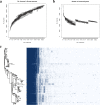Combing Immunoinformatics with Pangenome Analysis To Design a Multiepitope Subunit Vaccine against Klebsiella pneumoniae K1, K2, K47, and K64
- PMID: 35863000
- PMCID: PMC9431259
- DOI: 10.1128/spectrum.01148-22
Combing Immunoinformatics with Pangenome Analysis To Design a Multiepitope Subunit Vaccine against Klebsiella pneumoniae K1, K2, K47, and K64
Abstract
Klebsiella pneumoniae is an opportunistic Gram-negative bacterium that has become a leading causative agent of nosocomial infections, mainly infecting patients with immunosuppressive diseases. Capsular (K) serotypes K1, K2, K47, and K64 are commonly associated with higher virulence (hypervirulent Klebsiella pneumoniae), and more threateningly, isolates belonging to the last two K serotypes are also frequently associated with resistance to carbapenem (hypervirulent carbapenem-resistant Klebsiella pneumoniae). The prevalence of these isolates has posed significant threats to human health, and there are no appropriate therapies available against them. Therefore, in this study, a method combining immunoinformatics and pangenome analysis was applied for contriving a multiepitope subunit vaccine against these four threatening serotypes. To obtain cross-protection, 12 predicted conserved antigens were screened from the core genome of 274 complete Klebsiella pneumoniae genomes (KL1, KL2, KL47, and KL64), from which the epitopes of T and B cells were extracted for vaccine construction. In addition, the immunological properties, the interaction with Toll-like receptors, and the stability in a simulative humoral environment were evaluated by immunoinformatics methods, molecular docking, and molecular dynamics simulation. All of these evaluations indicated the potency of this constructed vaccine to be an effective therapeutic agent. Lastly, the cDNA of the designed vaccine was optimized and ligated to pET-28a(+) for expression vector construction. Overall, our research provides a newly cross-protective control strategy against these troublesome pathogens and paves the way for the development of a safe and effective vaccine. IMPORTANCE Klebsiella pneumoniae is an opportunistic Gram-negative bacterium that has become a leading causative agent of nosocomial infections. Among the numerous capsular serotypes, K1, K2, K47, and K64 are commonly associated with higher virulence (hypervirulent K. pneumoniae). More threateningly, the last two serotypes are frequently associated with resistance to carbapenem (hypervirulent carbapenem-resistant K. pneumoniae). However, there is currently no therapeutic agent or vaccine specifically against these isolates. Therefore, development of a vaccine against these pathogens is very essential. In this study, for the first time, a method combining pangenome analysis, reverse vaccinology, and immunoinformatics was applied for contriving a multiepitope subunit vaccine against K. pneumoniae isolates of K1, K2, K47, and K64. Also, the immunological properties of the constructed vaccine were evaluated and its high potency was revealed. Overall, our research will pave the way for the vaccine development against these four threatening capsular serotypes of K. pneumoniae.
Keywords: Klebsiella pneumoniae; carbapenem resistant; hypervirulent; immunoinformatics; multiepitope subunit vaccine; pangenome analysis.
Conflict of interest statement
The authors declare no conflict of interest.
Figures








Similar articles
-
Characterization difference of typical KL1, KL2 and ST11-KL64 hypervirulent and carbapenem-resistant Klebsiella pneumoniae.Drug Resist Updat. 2023 Mar;67:100918. doi: 10.1016/j.drup.2023.100918. Epub 2023 Jan 3. Drug Resist Updat. 2023. PMID: 36610180
-
The Molecular Epidemiology of Prevalent Klebsiella pneumoniae Strains and Humoral Antibody Responses against Carbapenem-Resistant K. pneumoniae Infections among Pediatric Patients in Shanghai.mSphere. 2022 Oct 26;7(5):e0027122. doi: 10.1128/msphere.00271-22. Epub 2022 Sep 7. mSphere. 2022. PMID: 36069436 Free PMC article.
-
Hypervirulent carbapenem-resistant Klebsiella pneumoniae causing highly fatal meningitis in southeastern China.Front Public Health. 2022 Oct 17;10:991306. doi: 10.3389/fpubh.2022.991306. eCollection 2022. Front Public Health. 2022. PMID: 36324461 Free PMC article.
-
Clinical Implications of Genomic Adaptation and Evolution of Carbapenem-Resistant Klebsiella pneumoniae.J Infect Dis. 2017 Feb 15;215(suppl_1):S18-S27. doi: 10.1093/infdis/jiw378. J Infect Dis. 2017. PMID: 28375514 Free PMC article. Review.
-
The case for a Klebsiella pneumoniae vaccine: A public health priority.Indian J Med Microbiol. 2025 Jul-Aug;56:100909. doi: 10.1016/j.ijmmb.2025.100909. Epub 2025 Jul 1. Indian J Med Microbiol. 2025. PMID: 40609832 Review.
Cited by
-
Geographical distribution, disease association and diversity of Klebsiella pneumoniae K/L and O antigens in India: roadmap for vaccine development.Microb Genom. 2024 Jul;10(7):001271. doi: 10.1099/mgen.0.001271. Microb Genom. 2024. PMID: 39037209 Free PMC article.
-
Integration of immunoinformatics and cheminformatics to design and evaluate a multitope vaccine against Klebsiella pneumoniae and Pseudomonas aeruginosa coinfection.Front Mol Biosci. 2023 Feb 14;10:1123411. doi: 10.3389/fmolb.2023.1123411. eCollection 2023. Front Mol Biosci. 2023. PMID: 36911530 Free PMC article.
-
Epitope-Based Vaccines: The Next Generation of Promising Vaccines Against Bacterial Infection.Vaccines (Basel). 2025 Feb 27;13(3):248. doi: 10.3390/vaccines13030248. Vaccines (Basel). 2025. PMID: 40266107 Free PMC article. Review.
-
Molecular epidemiology and clinical characteristics of the type VI secretion system in Klebsiella pneumoniae causing abscesses.Front Microbiol. 2023 May 17;14:1181701. doi: 10.3389/fmicb.2023.1181701. eCollection 2023. Front Microbiol. 2023. PMID: 37266024 Free PMC article.
-
Exploring current hypervirulent Klebsiella pneumoniae infections: insights into pathogenesis, drug resistance, and vaccine prospects.Front Microbiol. 2025 May 29;16:1604763. doi: 10.3389/fmicb.2025.1604763. eCollection 2025. Front Microbiol. 2025. PMID: 40510664 Free PMC article. Review.
References
-
- Tumbarello M, Trecarichi EM, De Rosa FG, Giannella M, Giacobbe DR, Bassetti M, Losito AR, Bartoletti M, Del Bono V, Corcione S, Maiuro G, Tedeschi S, Celani L, Cardellino CS, Spanu T, Marchese A, Ambretti S, Cauda R, Viscoli C, Viale P, Isgri S, ISGRI-SITA (Italian Study Group on Resistant Infections of the Società Italiana Terapia Antinfettiva). 2015. Infections caused by KPC-producing Klebsiella pneumoniae: differences in therapy and mortality in a multicentre study. J Antimicrob Chemother 70:2133–2143. doi:10.1093/jac/dkv086. - DOI - PubMed
Publication types
MeSH terms
Substances
LinkOut - more resources
Full Text Sources

